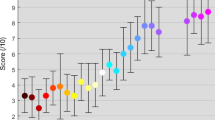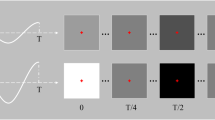Abstract
The problem of brain–computer interface (BCI) using steady-state visual evoked potential (SSVEP) is a flickering sensation caused by the flashing stimuli used to induce SSVEP. To use of high-frequency flashing stimuli is one of the countermeasures of this problem. This study focused on the relationship between the magnitude of SSVEP components for each subject and proposed a high-frequency (56–70 Hz) SSVEP–BCI that uses only the frequencies at which SSVEP induction was confirmed. For comparison, the accuracy of SSVEP–BCI using learning CCA (LCCA), an extension of canonical correlation analysis (CCA), was 98.61% for the low-frequency (26–40 Hz) SSVEP–BCI for comparison, 62.78% for the high frequency (56–70 Hz) SSVEP–BCI, and 87.19% for the high frequency (56–70 Hz) SSVEP–BCI with personalized stimulus frequency. As a result of comparing with and without personalization using information transfer rate (ITR), non-personalized (normal) and personalized high-frequency SSVEP–BCI ITR were 24.25 bits/min and 29.64 bits/min.






Similar content being viewed by others
Data availability
The electroencephalogram data used in this paper is obligated to be stored in a storage device that is not connected to the Internet based on the research ethics review for humans at Kogakuin University, so the data is not disclosed.
References
Vidal JJ (1973) Toward direct brain–computer communication. Ann Rev Biophys Bioeng 2(1):157–180
Lotte F, Bougrain L, Cichocki A et al (2018) A review of classification algorithms for EEG-based brain-computer interfaces: a 10 year update. J Neural Eng 15(3):1–28
Chen X, Wang Y, Nakanishi M et al (2014) Hybrid frequency and phase coding for a high-speed SSVEP-based BCI speller. In: 2014 36th Annual international conference of the IEEE engineering in medicine and biology society, Chicago Illinois, August 26–30 pp 3993–3996
Chen X, Chen Z, Gao S et al (2014) A high-ITR SSVEP-based BCI speller. Brain Comput Interfaces 1(3–4):181–191
Uchida M, Mizuno T (2013) An attempt on quantification evaluation of visual discomfort to the flickering stimuli by using nasal skin temperature (in Japanese). IEEJ Trans Electron Inf Syst 134(2):286–292
Kondo S, Tanaka H (2023) Development of SSVEP-BCI with Less flickering sensation. In: Proceedings of the international symposium on artificial life and robotics (AROB28th), Beppu, Oita Japan, January 25–27, 2023, pp 1277–1282
Fisher RS, Harding G, Erba G et al (2005) Photic-and pattern-induced seizures: a review for the Epilepsy Foundation of America Working Group. Epilepsia 46(9):1426–1441
Ministry of Health, Labour and Welfare (1998) Clinical study on photosensitive seizures (in Japanese). https://www.mhlw.go.jp/www1/houdou/1004/h0414-2.html. Accessed 08 Apr 2023
Zhu D, Bieger J, Mokina GG et al (2010) A survey of stimulation methods used in SSVEP-based BCIs. Comput Intell Neurosci 2010:1–12
Herrmann CS (2001) Human EEG responses to 1–100 Hz flicker: resonance phenomena in visual cortex and their potential correlation to cognitive phenomena. Exp Brain Res 137:346–353
Akaho S (2013) Introduction to canonical correlation analysis—mutual information extraction from multimodal observations. Societas Neurologica 20(2):62–72
Wolpaw JR, Ramoser H, McFarland DJ et al (1998) EEG-based communication: improved accuracy by response verification. IEEE Trans Rehabil Eng 6(3):326–333
Kondo S, Tanaka H (2022) The SSVEP-BCI for fifty-Hiragana Characters (in Japanese). In: Proceedings on human interface symposium 2022, Suita, Osaka Japan, August 31–September 2, 2022, pp 138–144
Rekrut M, Jungbluth T, Alexandersson J et al (2021) Spinning icons: introducing a novel SSVEP-BCI paradigm based on rotation. In: 26th International conference on intelligent user interfaces, College Station, Texas USA, April 14–17, pp 234–243
Author information
Authors and Affiliations
Corresponding author
Additional information
Publisher's Note
Springer Nature remains neutral with regard to jurisdictional claims in published maps and institutional affiliations.
This work was presented in part at the joint symposium of the 28th International Symposium on Artificial Life and Robotics, the 8th International Symposium on BioComplexity, and the 6th International Symposium on Swarm Behavior and Bio-Inspired Robotics (Beppu, Oita and Online, January 25–27, 2023).
About this article
Cite this article
Kondo, S., Tanaka, H. High-frequency SSVEP–BCI with less flickering sensation using personalization of stimulus frequency. Artif Life Robotics 28, 803–811 (2023). https://doi.org/10.1007/s10015-023-00893-9
Received:
Accepted:
Published:
Issue Date:
DOI: https://doi.org/10.1007/s10015-023-00893-9




